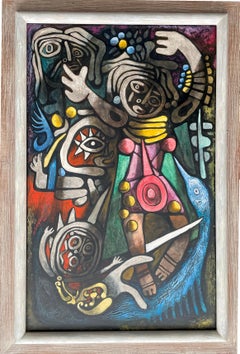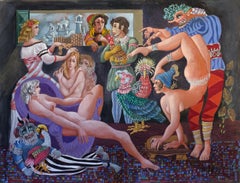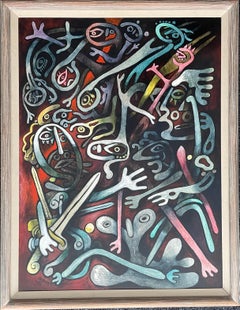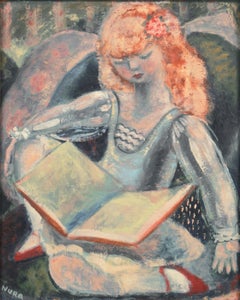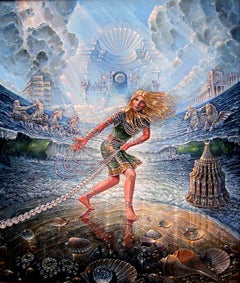Tempera Figurative Paintings
to
1
7
6
4
3
1
1
5
Overall Height
to
Overall Width
to
4
3
3
3
2
1
7
5
1
23
17
15
14
10
11
9
7
5
5
Artist: Julio de Diego
Medium: Tempera
Ceremonial Dancers oil and tempera painting by Julio De Diego
Located in Hudson, NY
Artwork measures 48" x 30" and framed 56 ¼" x 38 ¼" x 3"
Provenance:
John Heller Gallery, NYC, circa 1975 (label verso)
The artist's daughter
Corbino Galleries, Sarasota, FL (1990)...
Category
1940s Modern Tempera Figurative Paintings
Materials
Masonite, Oil, Tempera
Christmas Turkey & the General's Daughter painting by Julio De Diego
Located in Hudson, NY
The artwork measures 18" x 24", and the frame 25" x 29.5" x 1.75". Upon request a video clip of this work may be provided.
About this artist:
Julio De Diego crafted a formidable per...
Category
1960s Surrealist Tempera Figurative Paintings
Materials
Watercolor, Tempera, Paper
The Magician oil and tempera painting by Julio de Diego
Located in Hudson, NY
Julio De Diego’s Atomic Series paintings made an extraordinary statement regarding the shock and fear that accompanied the dawn of the nuclear age. In the artist’s own words, “Scientists were working secretly to develop formidable powers taken from the mysterious depths of the earth - with the power to make the earth useless! Then, the EXPLOSION! . . . we entered the Atomic Age, and from there the neo-Atomic war begins. Explosions fell everywhere and man kept on fighting, discovering he could fight without flesh.”
To execute these works, De Diego developed a technique of using tempera underpainting before applying layer upon layer of pigmented oil glazes. The result is paintings with surfaces which were described as “bonelike” in quality. The forms seem to float freely, creating a three-dimensional visual effect. In the 1954 book The Modern Renaissance in American Art, author Ralph Pearson summarizes the series as “a fantastic interpretation of a weighty theme. Perhaps it is well to let fantasy and irony appear to lighten the devastating impact. By inverse action, they may in fact increase its weight.”
Exhibited
1964 Marion Koogler McNay Art Institute, San Antonio, Texas
This work retains its original frame which measures 54" x 42" x 2"
About this artist: Julio De Diego crafted a formidable persona within the artistic developments and political struggles of his time. The artist characterized his own work as “lyrical,” explaining, “through the years, the surrealists, the social-conscious painters and the others tried to adopt me, but I went my own way, good, bad or indifferent.” [1] His independence manifested early in life when de Diego left his parent’s home in Madrid, Spain, in adolescence following his father’s attempts to curtail his artistic aspirations. At the age of fifteen he held his first exhibition, set up within a gambling casino. He managed to acquire an apprenticeship in a studio producing scenery for Madrid’s operas, but moved from behind the curtains to the stage, trying his hand at acting and performing as an extra in the Ballet Russes’ Petrouchka with Nijinsky. He spent several years in the Spanish army, including a six-month stretch in the Rif War of 1920 in Northern Africa. His artistic career pushed ahead as he set off for Paris and became familiar with modernism’s forays into abstraction, surrealism, and cubism.
The artist arrived in the U.S. in 1924 and settled in Chicago two years later. He established himself with a commission for the decoration of two chapels in St. Gregory’s Church. He also worked in fashion illustration, designed magazine covers and developed a popular laundry bag for the Hotel Sherman. De Diego began exhibiting through the Art Institute of Chicago in 1929, and participated in the annual Chicago Artists Exhibitions, Annual American Exhibitions, and International Water Color Exhibitions. He held a solo exhibition at the Art Institute of Chicago in the summer of 1935. Though the artist’s career was advancing, his family life had deteriorated. In 1932 his first marriage dissolved, and the couple’s young daughter Kiriki was sent to live with friend Paul Hoffman.
De Diego continued to develop his artistic vocabulary with a growing interest in Mexican art. He traveled throughout the country acquainting himself with the works of muralists such as Carlos Merida, and also began a collection of small native artifacts...
Category
1940s American Modern Tempera Figurative Paintings
Materials
Masonite, Oil, Tempera
St. Atomic oil and tempera painting by Julio de Diego
Located in Hudson, NY
Julio De Diego’s Atomic Series paintings made an extraordinary statement regarding the shock and fear that accompanied the dawn of the nuclear age. In the artist’s own words, “Scientists were working secretly to develop formidable powers taken from the mysterious depths of the earth - with the power to make the earth useless! Then, the EXPLOSION! . . . we entered the Atomic Age, and from there the neo-Atomic war begins. Explosions fell everywhere and man kept on fighting, discovering he could fight without flesh.”
To execute these works, De Diego developed a technique of using tempera underpainting before applying layer upon layer of pigmented oil glazes. The result is paintings with surfaces which were described as “bonelike” in quality. The forms seem to float freely, creating a three-dimensional visual effect. In the 1954 book The Modern Renaissance in American Art, author Ralph Pearson summarizes the series as “a fantastic interpretation of a weighty theme. Perhaps it is well to let fantasy and irony appear to lighten the devastating impact. By inverse action, they may in fact increase its weight.”
Exhibited
1950 University of Illinois at Urbana "Contemporary American Painting"
1964 Marion Koogler McNay Art Institute, San Antonio, Texas
This work retains its original frame which measures 54" x 36" x 2".
About this artist: Julio De Diego crafted a formidable persona within the artistic developments and political struggles of his time. The artist characterized his own work as “lyrical,” explaining, “through the years, the surrealists, the social-conscious painters and the others tried to adopt me, but I went my own way, good, bad or indifferent.” [1] His independence manifested early in life when de Diego left his parent’s home in Madrid, Spain, in adolescence following his father’s attempts to curtail his artistic aspirations. At the age of fifteen he held his first exhibition, set up within a gambling casino. He managed to acquire an apprenticeship in a studio producing scenery for Madrid’s operas, but moved from behind the curtains to the stage, trying his hand at acting and performing as an extra in the Ballet Russes’ Petrouchka with Nijinsky. He spent several years in the Spanish army, including a six-month stretch in the Rif War of 1920 in Northern Africa. His artistic career pushed ahead as he set off for Paris and became familiar with modernism’s forays into abstraction, surrealism, and cubism.
The artist arrived in the U.S. in 1924 and settled in Chicago two years later. He established himself with a commission for the decoration of two chapels in St. Gregory’s Church. He also worked in fashion illustration, designed magazine covers and developed a popular laundry bag for the Hotel Sherman. De Diego began exhibiting through the Art Institute of Chicago in 1929, and participated in the annual Chicago Artists Exhibitions, Annual American Exhibitions, and International Water Color Exhibitions. He held a solo exhibition at the Art Institute of Chicago in the summer of 1935. Though the artist’s career was advancing, his family life had deteriorated. In 1932 his first marriage dissolved, and the couple’s young daughter Kiriki was sent to live with friend Paul Hoffman.
De Diego continued to develop his artistic vocabulary with a growing interest in Mexican art. He traveled throughout the country acquainting himself with the works of muralists such as Carlos Merida, and also began a collection of small native artifacts...
Category
1940s American Modern Tempera Figurative Paintings
Materials
Masonite, Oil, Tempera
Inevitable Day – Birth of the Atom oil and tempera painting by Julio De Diego
Located in Hudson, NY
Julio De Diego’s Atomic Series paintings made an extraordinary statement regarding the shock and fear that accompanied the dawn of the nuclear age. In the artist’s own words, “Scientists were working secretly to develop formidable powers taken from the mysterious depths of the earth - with the power to make the earth useless! Then, the EXPLOSION! . . . we entered the Atomic Age, and from there the neo-Atomic war begins. Explosions fell everywhere and man kept on fighting, discovering he could fight without flesh.”
To execute these works, De Diego developed a technique of using tempera underpainting before applying layer upon layer of pigmented oil glazes. The result is paintings with surfaces which were described as “bonelike” in quality. The forms seem to float freely, creating a three-dimensional visual effect. In the 1954 book The Modern Renaissance in American Art, author Ralph Pearson summarizes the series as “a fantastic interpretation of a weighty theme. Perhaps it is well to let fantasy and irony appear to lighten the devastating impact. By inverse action, they may in fact increase its weight.”
Bibliography
Art in America, April 1951, p.78
About this artists: Julio De Diego crafted a formidable persona within the artistic developments and political struggles of his time. The artist characterized his own work as “lyrical,” explaining, “through the years, the surrealists, the social-conscious painters and the others tried to adopt me, but I went my own way, good, bad or indifferent.” [1] His independence manifested early in life when de Diego left his parent’s home in Madrid, Spain, in adolescence following his father’s attempts to curtail his artistic aspirations. At the age of fifteen he held his first exhibition, set up within a gambling casino. He managed to acquire an apprenticeship in a studio producing scenery for Madrid’s operas, but moved from behind the curtains to the stage, trying his hand at acting and performing as an extra in the Ballet Russes’ Petrouchka with Nijinsky. He spent several years in the Spanish army, including a six-month stretch in the Rif War of 1920 in Northern Africa. His artistic career pushed ahead as he set off for Paris and became familiar with modernism’s forays into abstraction, surrealism, and cubism.
The artist arrived in the U.S. in 1924 and settled in Chicago two years later. He established himself with a commission for the decoration of two chapels in St. Gregory’s Church. He also worked in fashion illustration, designed magazine covers and developed a popular laundry bag for the Hotel Sherman. De Diego began exhibiting through the Art Institute of Chicago in 1929, and participated in the annual Chicago Artists Exhibitions, Annual American Exhibitions, and International Water Color Exhibitions. He held a solo exhibition at the Art Institute of Chicago in the summer of 1935. Though the artist’s career was advancing, his family life had deteriorated. In 1932 his first marriage dissolved, and the couple’s young daughter Kiriki was sent to live with friend Paul Hoffman.
De Diego continued to develop his artistic vocabulary with a growing interest in Mexican art. He traveled throughout the country acquainting himself with the works of muralists such as Carlos Merida, and also began a collection of small native artifacts...
Category
1940s American Modern Tempera Figurative Paintings
Materials
Masonite, Oil, Tempera
Untitled
Located in Lawrence, NY
Provenance: Daughter of artist, Fletcher Gallery, Woodstock, NY
De Diego was known for his "lyrical" works (his term), which combined elements of surrealism, cubism and the social commentary of the politically active Mexican painters. Born in Madrid in 1900, Julio De Diego left home at the age of 15 to apprentice as a scene painter for theaters. After service in the Spanish army...
Category
1940s Surrealist Tempera Figurative Paintings
Materials
Tempera
Critics in a red cloud
Located in Miami, FL
Signed lower right . gilt frame some minor surface grime other than that is present very well with strong saturated colors
Category
Mid-20th Century Surrealist Tempera Figurative Paintings
Materials
Tempera, Oil
Related Items
'Story Time', Paris, Salon d'Automne, New York, ASL, Corcoran, PAFA, Art Deco
By Nura Ulreich
Located in Santa Cruz, CA
Signed lower left 'Nura' for Nura Woodson Ulreich (American, 1899–1950). Additionally signed, verso, dated March 1928 with artist's New York City ...
Category
1920s Surrealist Tempera Figurative Paintings
Materials
Oil, Illustration Board
H 20 in W 16 in D 0.25 in
"Our Lady of the Foam", John Stephens, Acrylic Painting, Surrealism, 24x30
Located in Dallas, TX
This John Stephens original acrylic on panel painting measures 24x30 in and is available for $27,500. "Our Lady of the Foam" features a woman inside a greek mythology dome covered in...
Category
2010s Surrealist Tempera Figurative Paintings
Materials
Panel, Acrylic
1970s Abstract Figurative Framed Oil Painting, Modernist City Scene With Couple
Located in Denver, CO
1950s oil on board painting by George Cecil Carter portraying a modernist couple, thought to be Alfred Stieglitz & Georgia O'Keefe. Presented in a custom frame, outer dimensions measure 20 ⅝ x 13 ½ x 1 ⅞ inches. Image sight size is 16 ⅞ x 9 ⅞ inches.
Painting is clean and in very good vintage condition - please contact us for a complete condition report.
Provenance: Private Collection, Denver Colorado
Expedited and international shipping is available - please contact us for a quote.
About the Artist:
George Cecil Carter was born in Oklahoma in 1908 and became a noted Colorado abstract expressionist alongside contemporaries including Al Wynne, Mary Chenoweth...
Category
1950s American Modern Tempera Figurative Paintings
Materials
Oil, Board
H 20.5 in W 13.5 in D 1.75 in
Nocturnal Train In The City Abstract Expressionism
By Tom Hamil
Located in Soquel, CA
Bright, small abstract expressionist painting of train and town at night by Tom Hamil (American, b. 1928). Signed upper left corner "Hamil". Condition: Excellent. Presented in rustic wooden shadow box frame. Image size: 8"H x 6"W.
Tom Hamil, was born in New York in 1928 and raised primarily in California. After attending the US Naval Academy in Annapolis, he returned to California to begin his formal art training at the California School of Fine Arts in San Francisco (now known as the San Francisco Art Institute). He completed his education at the University of Washington with a Master’s Degrees and Doctorate in Fine Arts and Education. His first solo exhibition was held in 1956. Since then, he has participated in numerous one man shows, group shows, and has been represented in galleries in the US and Mexico.
In addition to his painting, Hamil has authored and illustrated a number of books. While at the Naval Academy, he received recognition for his paintings, drawings, and illustrations. Listed among Hamil’s many awards and honors are a Ford Foundation Fellowship and an Award of Excellence from the American Graphics Society.
Currently, he lives in Zirahuen, Michoacan, Mexico and Truth or Consequences, New Mexico. Hamil’s statement: “I am a man...
Category
1960s Abstract Expressionist Tempera Figurative Paintings
Materials
Masonite, Oil
"Tour through the universe", 2022. Fantastic Realism painting golden
Located in Bogotá, Bogotá
A tour of the universe, a visit to another invisible world where you can live in peace. The beloved animals and us united in one life. "Around the universe” Figurative Painting 51" x...
Category
2010s Surrealist Tempera Figurative Paintings
Materials
Oil, Acrylic
Free Shipping
H 51.19 in W 64.18 in D 0.4 in
Heinrich Richter "#50", 1969
Located in Washington, DC
Oil on canvas painting by Heinrich Richter (German/Polish, 1920-2007). Painting is titled #50, signed and dated 1969. Heinrich Richter has had numerous solo and group exhibitions in ...
Category
1960s Surrealist Tempera Figurative Paintings
Materials
Canvas, Oil
Looking Away - Figurative Abstract
Located in Soquel, CA
A figurative abstract painting on masonite by San Francisco, California area artist Daniel David Fuentes (American, 1978-2016). San Francisco Bay Area abstract expressionist and land...
Category
1990s Abstract Expressionist Tempera Figurative Paintings
Materials
Masonite, Oil
Surrealist scene oil on canvas painting surrealism
Located in Barcelona, Barcelona
Oil on canvas.
Signed Aress.
Oil mesures 33x24 cm.
Frame mesures 48x39 cm.
Category
1990s Surrealist Tempera Figurative Paintings
Materials
Oil, Canvas
SURREALISTIC VIEW (MARGRITTE MIRO)
Located in Aventura, FL
Original painting on canvas. Hand signed on front by Ferjo. Canvas is stretched.
Artwork is in excellent condition. Certificate of authenticity included. All reasonable offers wil...
Category
21st Century and Contemporary Surrealist Tempera Figurative Paintings
Materials
Oil, Canvas
surreal scene oil on canvas painting surrealism
Located in Barcelona, Barcelona
Francesc Gironés (1904-1997) - Surrealist scene - Oil canvas
Oil measures 38x46 cm.
Frame measures 47x55 cm.
Francesc Gironés was a painter from Poblenou about whom little is known,...
Category
1980s Surrealist Tempera Figurative Paintings
Materials
Canvas, Oil
Mid-Century Modern Abstract Geometric Trapeze Artists by Hilda Arp
By Hilda Arp
Located in Soquel, CA
Fanciful mid-century modern abstract of trapeze artists by Brooklyn artist Hilda Dora Pape Arp (b. 1909). This 1962 highly abstracted depiction of trape...
Category
1960s American Modern Tempera Figurative Paintings
Materials
Oil, Linen
H 28 in W 22 in D 3 in
20th C. Figurative Abstract Painting Cleveland School African American Artist
By Beni E. Kosh
Located in Beachwood, OH
Beni E. Kosh/Charles Elmer Harris (American, 1917-1993)
Untitled
Oil on canvas board
Estate stamped #611 verso
24 x 18 inches
Charles Elmer Harris was born in 1917 in Cleveland, Oh...
Category
20th Century American Modern Tempera Figurative Paintings
Materials
Oil
Previously Available Items
Admirable Cat Analyzed by the Bourgeoisie
Located in Saint Augustine, FL
An original signed Tempera by Spanish artist Julio de Diego (1900-1979), titled "Admirable Cat Analyzed by the Bourgeoisie", c. 1950s. Hand signed lower right. A great image, wonderf...
Category
1950s Surrealist Tempera Figurative Paintings
Materials
Tempera
Tempera figurative paintings for sale on 1stDibs.
Find a wide variety of authentic Tempera figurative paintings available on 1stDibs. While artists have worked in this medium across a range of time periods, art made with this material during the 21st Century is especially popular. If you’re looking to add figurative paintings created with this material to introduce a provocative pop of color and texture to an otherwise neutral space in your home, the works available on 1stDibs include elements of blue, orange, purple, yellow and other colors. There are many well-known artists whose body of work includes ceramic sculptures. Popular artists on 1stDibs associated with pieces like this include Miyuki Takanashi, Sergio Barletta, Alkis Matheos, and Barnaby Fitzgerald. Frequently made by artists working in the Contemporary, Modern, all of these pieces for sale are unique and many will draw the attention of guests in your home. Not every interior allows for large Tempera figurative paintings, so small editions measuring 0.1 inches across are also available
